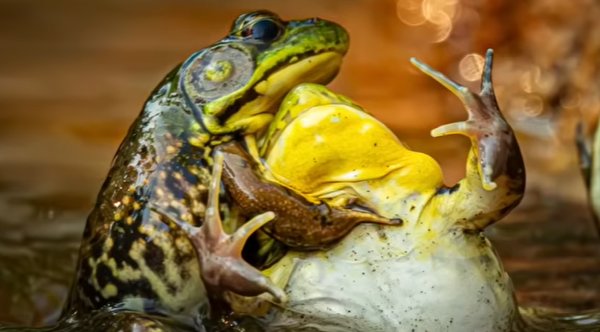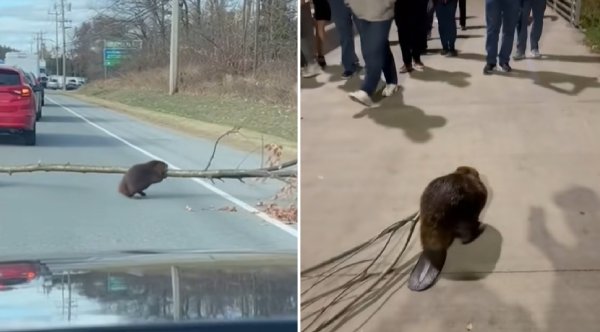Rainbow of Colorful Critters Discovered in Suriname
February 3, 2012
A scientific expedition into one of the world's last pristine tropical forests has revealed incredibly diverse species and extraordinary cultural heritage, said Conservation International (CI) today, announcing the results of a scientific survey in southwest Suriname that documented nearly 1,300 species, including 46 species which may be new to science. The announcement comes as the global organization marks 25 years of science-based conservation, this month.
The three-week survey, an initiative of CI's long-standing Rapid Assessment Program (RAP), explored three remote sites along the Kutari and Sipaliwini Rivers near the village of Kwamalasumutu from August to September 2010, in an effort to document the region's poorly known biodiversity and help develop sustainable ecotourism opportunities for the local indigenous people. The research was conducted by a collaborative team of 53 scientists, indigenous Trio people, and students, who documented the diversity and status of plants, fishes, reptiles and amphibians, birds, small mammals, large mammals, ants, katydids, dragonflies and damselflies, aquatic beetles, and dung beetles.
CI scientist and Rapid Assessment Program Director Dr. Trond Larsen said, "Our team was privileged to explore one of the last remaining areas of vast, unroaded wilderness in the world. As a scientist, it is thrilling to study these remote forests where countless new discoveries await, especially since we believe that protecting these landscapes while they remain pristine provides perhaps the greatest opportunity for maintaining globally important biodiversity and the ecosystems people depend upon for generations to come."
The findings of the expedition were recently published in the RAP Bulletin of Biological Assessment series, titled "A Rapid Biological Assessment of the Kwamalasamatu region, Southwestern Suriname". Among the many highlights, scientists report new species that include a large tree-frog, eight freshwater fish, and dozens of new insects such as aquatic beetles, dung beetles, damselflies, and katydids.
See the photos of the newly discovered species: www.smugmug.com/gallery/20915958_cfTtMX
"Cowboy Frog" — Hypsiboas sp. has white fringes along the legs, and a spur on the "heel." It was discovered low on a small branch during a night survey in a swampy area of the Koetari River. The main distinguishing characteristic of this frog is the lack of a certain characteristic. It looks quite similar to "the Convict Treefrog" Hypsiboas calcaratus but lacks the black and white lateral stripes of H. calcaratus.
"Armored Catfish" — Pseudacanthicus sp. is a catfish whose armor (external bony plates) is covered with spines to defend itself from giant piranhas which inhabit the same waters.
Interestingly, one of the local guides on the expedition was about to eat this specimen as a snack, until scientists noticed its unique characteristics and preserved it as a specimen.
Only a handful of Pseudacanthicus specimens are known from Suriname, and this is the first from the Sipaliwini.
"Crayola Katydid" — Vestria sp. known as Crayola katydids because of their striking coloration. They are the only katydids known to employ chemical defenses, which are effective at repelling bird and mammalian predators.
A flagship initiative of Conservation International since 1990, "RAP" surveys provide a quick assessment of the unique biodiversity of an area to inform conservation and sustainable development, often identifying species in remote underexplored regions.
While the discovery of new species is an exciting outcome of these surveys, the RAP scientists also observed a variety of other fascinating species, many of which are found only in Suriname or represent entirely new records for the region. A few of the amazing species found were:
See photos of other species here: www.smugmug.com/gallery/20354885_WpT4WM
"Pac-Man Frog" — Ceratophrys cornuta is a voracious sit-and-wait predator with an exceptionally wide mouth that allows it to swallow prey that is nearly as large as its own body, including birds, mice and other frogs. One researcher using a radio collar to track birds found her study animal (and collar) in the belly of this frog!
"Great Horned Beetle" — Coprophanaeus lancifer is a massive dung beetle the size of a tangerine, weighing over 6 grams. It is metallic blue and purple. This species is highly unusual in that both males and females possess long horns on the head, which are used as weapons against each other during battle.
"Spectacular Conehead Katydid" — Loboscelis bacatus was previously only known from Amazonian Peru. The katydid has fluorescent green and pink coloring. The sighting in southern Suriname significantly extends its known range. It is predator of insects and snails, and feeds on seeds and fruits.
"The area was paradise for the entomologists among us, with spectacular and unique insects everywhere. I didn't even have to look for ants because they jumped out at me", said Dr. Leeanne Alonso, a former CI RAP Director who is now with Global Wildlife Conservation. "Other scientists were equally impressed with the amazing diversity of birds and mammals of the region. You can really get up close to wildlife here - a camera trap recorded a jaguar about one hundred yards from our camp."
You may read this press release in its original location and view more photos: www.conservation.org/newsroom/pressreleases/Pages/An-Armored-Catfish-Cowboy-Frog-and-a-Rainbow-of-Colorful-Critters
Click Here For The Most Popular On Sunny Skyz
 Boy With Down Syndrome Nails The Whitney Houston Challenge, And The Crowd Goes Wild
Boy With Down Syndrome Nails The Whitney Houston Challenge, And The Crowd Goes Wild
 The Funniest Wildlife Photos Of 2025 Are Here ŌĆö And TheyŌĆÖre Hilarious
The Funniest Wildlife Photos Of 2025 Are Here ŌĆö And TheyŌĆÖre Hilarious
 This 30-Year-OldŌĆÖs Christmas Gift To His Mom Is Going Viral
This 30-Year-OldŌĆÖs Christmas Gift To His Mom Is Going Viral
 A Couple Invited A Homeless Man In On Christmas ŌĆö And He Never Left
A Couple Invited A Homeless Man In On Christmas ŌĆö And He Never Left
 Police 'Arrest' A Lost Cat For 'Assault' ŌĆö And She Has No Regrets
Police 'Arrest' A Lost Cat For 'Assault' ŌĆö And She Has No Regrets
 Police OfficerŌĆÖs Simple Question Leads To An Unforgettable Christmas Moment
Police OfficerŌĆÖs Simple Question Leads To An Unforgettable Christmas Moment
 He Asked For Help Wrapping A Christmas Present ŌĆö Then Surprised Her With A Life-Changing Gift
He Asked For Help Wrapping A Christmas Present ŌĆö Then Surprised Her With A Life-Changing Gift
 This Teacher Found A Simple Way To Make Every Student Feel Loved
This Teacher Found A Simple Way To Make Every Student Feel Loved
 Beaver Casually Drags Branch Through Public Area While People Cheer
Beaver Casually Drags Branch Through Public Area While People Cheer
 Coldplay's Chris Martin Surprises Couple At Wedding
Coldplay's Chris Martin Surprises Couple At Wedding
 90-Year-Old Grandma Gets Her Very First Doll On Christmas ŌĆö The Tears Say It All
90-Year-Old Grandma Gets Her Very First Doll On Christmas ŌĆö The Tears Say It All

